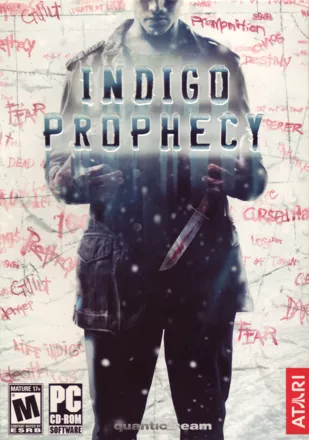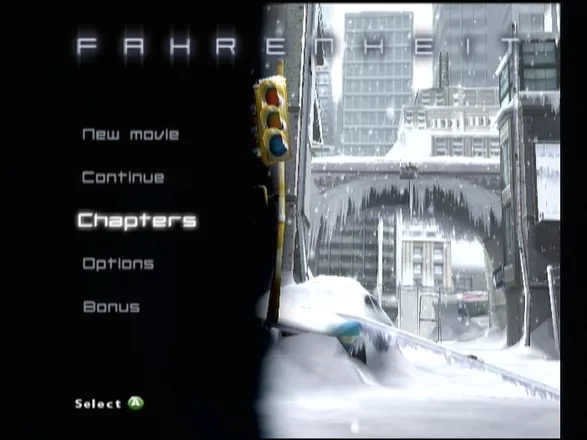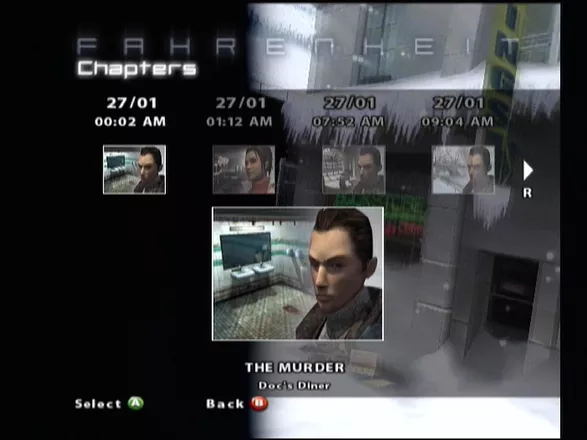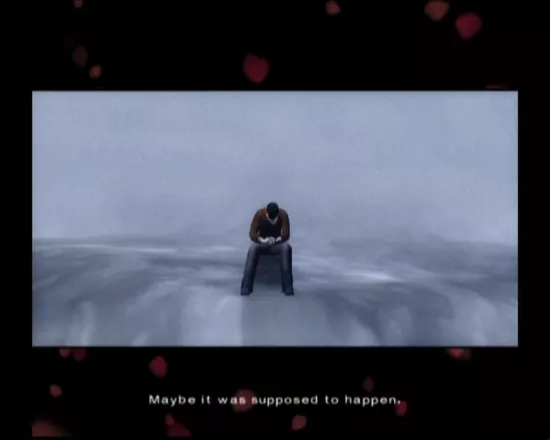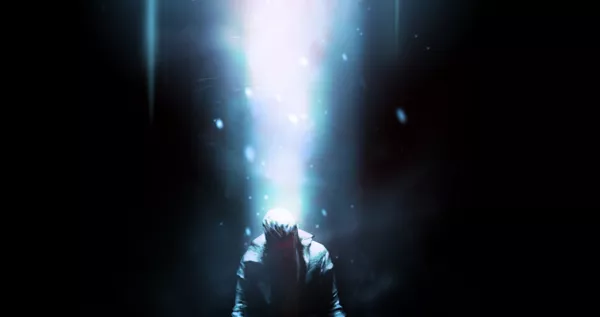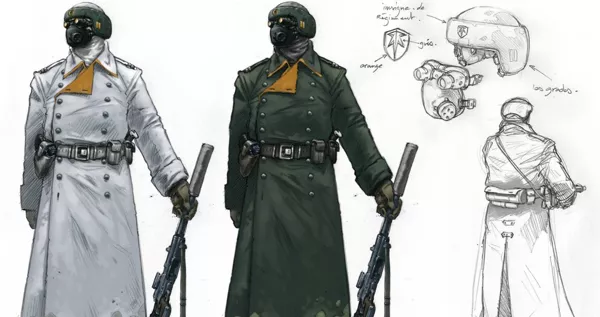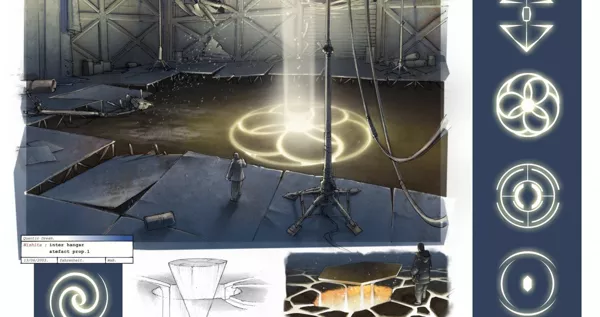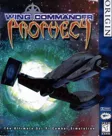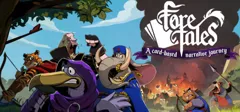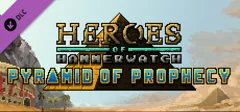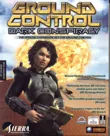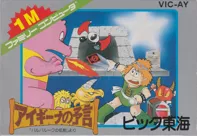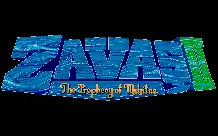Indigo Prophecy
Description official descriptions
January 2009. On a cold, snowy night in New York City, an ordinary citizen named Lucas Kane, under the control of an unknown force, unwillingly murders a complete stranger in a diner. Once he comes to senses, Lucas realizes he must escape while leaving as little evidence as possible behind. Barely managing to accomplish that, Lucas contacts his brother and tries to understand what has caused him to commit the crime, recalling the events of his own past in the process. Meanwhile, two police detectives investigating the murder, Carla Valenti and Tyler Miles, are determined to find the perpetrator, at the same time trying to deal with the personal problems of their lives.
Indigo Prophecy (Fahrenheit in Europe) is a psychological thriller in which the player is able to control different characters on both sides of a murder - the killer and those who are trying to find him. The game's core gameplay style is adventure. The three protagonists explore various locations, talk to other characters, and interact with the environment in order to advance. However, the game is heavy on various action-oriented sequences, from tasks that must be completed within a limited amount of time to quick time events, which require the player to press the correct button during a scene.
The game emphasizes realism in the player's interaction with the environment. For example, picking up a rag and cleaning the floor requires the player to move the mouse or the analog stick back and forth, imitating the actual movements of the object. Dialogue with character often imposes time limits on the player; failure to choose the optimal response in time will prompt the game to choose another, not always the optimal one. The player's choice will sometimes influence the subsequent events and the outcome of the entire story, eventually leading it to one of the three possible endings.
Cinematic treatment is evident in the game's handling of action-based gameplay and cutscenes, which are often seamlessly integrated into each other. An example of this is the split-screen technique, which is often used during the game's most dramatic moments: while the player is trying to complete the required action in time on one screen, another one displays what is happening around the controlled character.
Spellings
- 全面失控 - Traditional Chinese spelling
- 靛青预言 - Simplified Chinese spelling
- 인디고 프로페시 - Korean spelling
Groups +
- Best of Infogrames / Atari releases
- Gameplay feature: "Simon says"
- Gameplay feature: Multiple endings
- Indigo Prophecy / Fahrenheit games
- Nudity
- PC Gamer Presents games
- Protagonist: Hunter & Hunted
- Setting: City - New York
- Setting: Future now past
- Software Pyramide releases
- Technology: amBX
- Theme: Law enforcement
Screenshots
Promos
Videos
Add Trailer or Gameplay Video +1 point
See any errors or missing info for this game?
You can submit a correction, contribute trivia, add to a game group, add a related site or alternate title.
Credits (Windows version)
192 People (189 developers, 3 thanks) · View all
| Director | |
| Executive Producer | |
| Assistant Project Manager | |
| Production Assistant | |
| Engine Manager | |
| Platform Managers | |
| 3D Engine | |
| Tools Manager | |
| Tools | |
| Design | |
| Graphic Manager | |
| Lead Characters | |
| Senior Artist | |
| [ full credits ] | |
Reviews
Critics
Average score: 84% (based on 96 ratings)
Players
Average score: 3.8 out of 5 (based on 212 ratings with 15 reviews)
Wonderful and Awful at the same time
The Good
Here it is 2 years after the release of Indigo Prophecy and I'm just now getting around to playing it. Why? I suppose that the adventure gamer side of me avoided it like a hot potato because of the purported "action" segments. Yes, I realize that all of the major gaming websites (even the adventure sites) gave it high marks, but that still didn't compel me to purchase the game. All the while the role-player in me was whispering to my subconscious "You should get this game" .. "Go ahead, what have you got to lose?" When I found it really cheap on eBay, I gave in and bought it several months ago. But still - I let it sit on my shelf, opting instead for other standard point-and-click style games. Now that I've gotten into it, I can write my biased opinions in this review. Was I sorry? Was it as good as everybody said? Read on.
First looks at the game can be intimidating and exciting at the same time. The story grabbed me during the introduction as I watched a man under the influence of a mind-controlling force committing a terribly bloody murder. Afterwards he is aghast as what he has done and extremely "dazed and confused." Since I had gone through the beginning tutorial (which I urge you to do), I helped my character perform the beginning actions to clean up the mess and proceed to getting away from the crime scene. Two more characters arrive to investigate the crime and I proceeded to guide each of them through their various tasks, looking for evidence, talking to witnesses and between themselves. Okay, I said to myself, this isn't so hard. I can do this!
Ultimately strong is Indigo Prophecy's storyline and character development. Set in the year 2009, it feels like a mix of CSI and the X-Files - criminology, science-fiction and the paranormal. While playing the four different characters, it's necessary to keep them healthy - in mind, mood as well as in body. So sleeping, eating, taking a shower, listening to music and other every day actions are part of the gameplay. For me, these simple things helped me identify with the characters and added to the realism factor. Listening to their thoughts also brought the characters to life.
Viewing scenes in split-screen is a bit disorienting at first because it's hard to look at all screens at once. But this is one of the things that the major review sites lauded as innovative.
I thoroughly loved the music which added so much to the feelings I had while playing. Those feelings included apprehension, excitement, shock and sympathy.
The Bad
Oh, this part is so very disappointing. I really wanted to love Indigo Prophecy as much as everyone else, but I just couldn't. It all boils down to my inability to get through the action segments. I tried - I really did - but I couldn't master the "flying fingers" technique of frantically punching keyboard keys in the proper order. I died and I died and I died again until my frustration led me to uninstall the game after 2 days of play. I played the game from the beginning in the Easy mode and still couldn't get it. I'd hate to think what it would be like for the color-blind.
In my opinion, this game should have been redesigned completely for the PC to allow mouse-only action. Leave the arrow keys for movement as an option, but take away the number pad entirely. As for the mouse control that exists, it's different to say the least. The drag-hold and drag back-and-forth quickly in various directions was not what I consider ease of control either.
The Bottom Line
As I said above, the story is absolutely the best part of the game. Graphics are good, too, especially those of the characters in motion. Mood-inspiring music, great character back story and top-notch voice acting are additional pluses.
Indigo Prophecy is a wonderful game, if you are adept with the keyboard and have good reflexes. Having a gamepad connected to your PC would be of major help here since many portions of the interface are console-like.
I'm upset that I can't finish the game. If you like action in your adventures, this might be the game for you. Point-and-click adventure fans may find it as frustrating as I did.
Windows · by Jeanne (75944) · 2007
The Good
- Clever use of multiple view angles (à-la-24)
- very strong story start.
- good immersion,sense of urgency very present.
- Overall first 1/2 of game solid.
The Bad
Right about half point :
- False sense of choice
(its either "game over" or go on, no branching tree story) - You realize whatever you did in the past is irrelevant.
- Story quickly dwindles, you end up doing menial irrelevant things or just pushing buttons for the story to continue
- Ending is... well, very, very bad.
The Bottom Line
Ingenious design. Brilliant concept. Poorly executed.
Once you realize that nothing matters, it leaves a rather bitter taste.
PlayStation 2 · by Nicolas Nadeau (2) · 2006
Probably one of the best games out there...
The Good
One of the most impressive features of the game is its cinema-style presentation. You can basically shape the story based on the choices you make. Although the story itself deviates a little by your choices, it is still a great feature.
Personally, I was very impressed with this game when it first came out. I had very low expectations of this game at first since I really didn’t quite understand what all the fuss was about. After playing the first 10 minutes, I was blown away. I couldn’t believe how great the game was and I couldn’t stop playing it.
The game unfolds like a movie. So explaining the game mechanics is hard to explain without spoiling much of the fun. In other words, the game must be experienced, not heard about.
If I remembered correctly, you can play three different characters; with each character’s story intertwining each other.
The Bad
There are four things I really didn’t like in this game.
The first is the stress system. I don’t know if it’s actually called the stress system, but I think the name is appropriate. The stress system is basically your mental state throughout the game. Depending on what dialogue choices you make, actions you take, and things you see, your stress level can increase or decrease. If you’re happy and alert, you can handle certain things; however, if your stress level is very high, the game can end if you pick the wrong choices. For example, listening to music can make your stress level reduced. However, if you watch news reports about yourself, your stress can increase. If you are so stressed out, and you happen to do something that furthers increase your stress, the game ends.
The stress system is great, in my opinion. However, the problem with it involves what can increase and decrease your stress level. The game isn’t exactly clear on it and sometimes if your stress is really high, and the next scene involves your stress level increasing, your game can end.
The next thing I really didn’t like is the “plot twist.” Of course I won’t spoil it for anyone, but I think everyone who played the game thought to themselves, “Where the heck did that come from?!?!” The plot twist is really out of place and nothing seems to build upon it from previous dialogues and scenes. It made it appear as if the developers had an original story, then somewhere along the line they decided to throw in this plot twist without any time to fit it around the earlier scenes.
The next thing I really didn’t like was the interaction within the game. The game plays a bit of a “Simon Says,” where you have to move your left and right analog sticks according to what’s given on the screen. It’s alright, but it presents no challenge to the game. Basically, the two sure ways you can die in this game is by the stress level or missing a sequence to this “Simon Says” thing.
The final thing I didn’t like was the game’s length. The game was very short compared to other games. I think the game itself can be played in 4-6 hours.
The Bottom Line
I recommend this game to anyone who wants an interesting story, and a fantastic game. The game is very hard to explain in words and it’s best to just go out and play the game.
PlayStation 2 · by Daniel Allen (13) · 2007
Discussion
| Subject | By | Date |
|---|---|---|
| Skipping cutscenes | DreinIX (10446) | Sep 25, 2009 |
Trivia
1001 Video Games
Fahrenheit appears in the book 1001 Video Games You Must Play Before You Die by General Editor Tony Mott.
Cut Content
In the U.S. version, the sex scenes have been toned down to maintain a Mature rating.
Development
- Fahrenheit was first announced as an episodic game. With this business model, Quantic Dream wanted to sell the game at a budget price, and then release monthly episodes and half-yearly bundles. This concept allowed for cliff-hangers, red herrings, mysteries, and surprises, with a new build-up in hype every month. Ultimately, they did not go along with it and released the game as a whole, at a regular price.
- The game was in development for five years - two years to create the tools and engine, two years to develop the game, and an additional year to sell it to the publisher.
Genre
The developers themselves do not call the game an adventure, but rather interactive drama, a story that is evolving according to the player's choices in the game, where gameplay is the story. It consists of bending stories, with a beginning, a middle and an end, but everything in between can be stretched or has multiple paths.
Publishing
The game was first to be published by Vivendi Universal, but developer and publisher parted ways in November 2004 because of differences in creative vision.
References
- Early in the game when the player wakes up as Tyler there is a desk in the bedroom with an action figure on it that when checked says: "This is a figurine of Sox, a character from my favorite videogame." Sox is a robot from another Quantic Dream game, Omikron: The Nomad Soul.
- At one point of the game there's also news about Omikron on the Internet. It can be accessed from Tyler's computer at the police station. Notice also how much the archive computer in the basement of the police station looks like a Commodore VIC-20.
- The concept of an Indigo Child is an actual theory, though not quite the same as the game presents it.
Technology
The game contains thirteen hours of full body and facial animation, which, according to the developers, has never been done in a video game, a TV series, or a film.
Tutorial
In the tutorial, the player is introduced to the game in a training room by director David Cage, not just with a voice-over, but using a rendered model as well. He also briefly discusses his creative vision.
U.S. Title
The decision to rename the game Indigo Prophecy in the U.S. was made by Atari. Fahrenheit suggests September 11th because of Michael Moore's critical film Fahrenheit 9/11, even though it's equally well known as a temperature scale, or in reference to Ray Bradbury's book Fahrenheit 451.
Awards
- 4Players
- 2005 – Best Adventure of the Year
- 2005 – Best Innovations of the Year
- GameSpy
- 2005 – PC Adventure Game of the Year
- 2005 – PC Adventure Game of the Year (Readers' Vote)
- Golden Joystick Awards
- 2005 - Unsung Hero of the Year* PC Powerplay (Germany)
- Issue 04/2006 - #2 RPG/Adventure in 2005 (Readers' Vote)
- Issue 02/2006 - Most Innovative Adventure in 2005
Information also contributed by Jeanne, Mr. Sefe, piltdown man and Zack Green.
Analytics
Upgrade to MobyPro to view research rankings!
Related Sites +
-
Developer's diary
An extensive post-mortem by director David Cage. -
FAQs and Guides
on GameFaqs.com -
Fahrenheit
Official Web Site -
UHS Hints for Indigo Prophecy
Nudges you along so you can try to solve the game yourself. Given in question and answer format. Includes full solutions. -
Walkthrough by Grawl
posted on GamesOver -
Zarf's Mini-Review
A mini-review of the PlayStation 2 version of Indigo Prophecy by Interactive Fiction developer Andrew Plotkin (June, 2006).
Identifiers +
Contribute
Are you familiar with this game? Help document and preserve this entry in video game history! If your contribution is approved, you will earn points and be credited as a contributor.
Contributors to this Entry
Game added by Jeanne.
PlayStation 4 added by Sciere. Xbox 360 added by Parf.
Additional contributors: Unicorn Lynx, Sciere, Zeppin, Paulus18950, Patrick Bregger, Rik Hideto, FatherJack.
Game added September 20, 2005. Last modified February 23, 2024.
